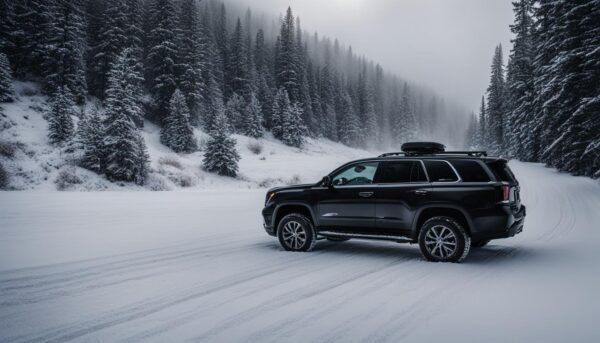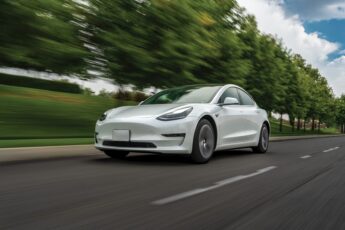Last Updated on 8 months
Master Winter Roads with the Right Tire Change Strategy
With the winter season comes unpredictable and potentially hazardous weather conditions, making it essential for drivers to prioritize safety measures, including installing season-specific tires. Car owners should be aware of the numerous benefits of changing tires for winter and how these specific tires increase winter driving safety. In this article, we will explore the importance of winter tire change, the process of winter tire installation, and the various winter tire benefits that contribute to safe driving in cold and icy conditions.
Key Takeaways
- Changing tires for winter is crucial for maintaining safety in unpredictable winter weather.
- Winter tires are designed for optimal performance in cold and icy conditions.
- Proper winter tire installation increases traction, braking ability, and handling on slippery surfaces.
- Investing in winter tires helps prevent accidents and improves overall winter driving safety.
- Winter tire change is essential on all vehicle types, including all-wheel drive and four-wheel drive vehicles.
- Timely winter tire installation can give drivers a safer and more confident driving experience during the colder months.
The Science Behind Winter Tires and Their Traction
Winter tires are carefully engineered to maintain winter tire safety and provide drivers with increased control during hazardous conditions. These tires have a unique rubber compound that allows them to stay flexible and maintain elasticity at lower temperatures, substantially enhancing winter tire traction on snowy and icy surfaces. The secret lies in the winter tire technology responsible for these impressive characteristics, which ensures superior grip and handling for safely navigating ice road conditions.
The specialized rubber compound in snow tires has a more extensive silica content that enhances the tire’s flexibility, enabling it to maintain contact and grip the road surface in extreme cold. This improved traction is vital in controlling drivers during hazardous winter weather events, such as sleet and heavy snowfall. Ultimately, this contributes to a motorist’s ability to brake, accelerate, and corner effectively during winter emergencies.
Increased traction from winter tires is crucial for maintaining control during challenging winter driving conditions, helping drivers brake and maneuver effectively in slippery situations.
Let’s take a closer look at how different aspects of winter tire technology help deliver better performance and safer driving experiences even during the most adverse of winter conditions:
| Aspect | Function | Impact on Safety |
|---|---|---|
| Special Rubber Compound | Maintains flexibility and elasticity at low temperatures | Improved grip and traction on icy and snowy roads |
| Larger Silica Content | Enhances tire flexibility, ensuring optimal contact with the road surface | Increased control in hazardous winter conditions, including sleet and heavy snowfall |
Understanding the various factors within winter tire technology can help drivers make informed decisions about when and how to use winter tires to ensure maximum safety and ice road safety during the colder months.
Key Takeaways:
- Winter tires are designed with unique rubber compounds to provide enhanced grip and traction on icy and snowy surfaces.
- Increased traction improves braking, acceleration, and cornering capabilities in winter conditions.
- Understanding the science behind winter tires can help drivers make better choices, ensuring better road safety during winter.
Understanding the Rubber Compounds of Winter Tires
Winter tires are specifically engineered to perform at their peak in cold weather conditions. The rubber compounds play a crucial role in enhancing tire performance, and the significant difference between the compounds used in winter and those used in all–season tires makes it essential to use the appropriate tire for the given season.
Flexibility in Cold Weather Explained
Cold-weather tire flexibility is essential to maintaining a solid grip on the road. In freezing temperatures, traditional all-season tires may harden and become less effective. On the other hand, winter tire rubber compounds are designed to remain pliable even as temperatures drop below 40º F. This specialized rubber ensures consistent performance and safety in cold climates, making them indispensable for vehicles in such regions.
The Importance of Silica Content in Winter Tires
One of the significant components contributing to the flexibility and effectiveness of winter tires in cold climates is the silica content. Silica is used in tire compounds to enhance their ability to remain soft and flexible in extremely low temperatures. The higher silica content in winter tire compounds results in improved traction on icy roads and better braking and handling capabilities, which are crucial for preventing accidents during the winter season.
| Components | Winter Tires | All-Season Tires |
|---|---|---|
| Rubber Compounds | Flexible in low temperatures | Hardens in low temperatures |
| Silica Content | High | Low |
| Tire Grip in Cold Temperatures | High | Low |
In conclusion, knowing the different rubber compounds in winter tires is essential for understanding their optimal performance in cold weather conditions. These unique compounds are at the core of safe winter driving, as they provide vehicles with significantly improved grip, better flexibility, and enhanced traction on icy roads compared to traditional all-season tires.
Key Design Differences: Winter vs All-Season Tires
Several key design features set them apart when comparing winter and all-season tires. These differences are crucial in providing optimum performance and safety for drivers during cold, snowy, and icy conditions. These distinguishing characteristics include tire design for winter, tire tread patterns, and siping in tires.
- Deeper Tread Patterns: Winter tires have deeper tread patterns specifically tailored to efficiently clear snow, slush, ice, and water from the tire. This maintains contact with the road and prevents snow buildup, enhancing traction and vehicle control. On the other hand, all-season tires generally have shallower treads that are less capable of handling severe winter conditions, potentially becoming packed with snow and losing traction.
- Increased Siping: Siping refers to the thin slits or grooves cut into a tire’s tread to provide better gripping edges on slippery surfaces. Winter tires typically have more siping than all-season tires, increasing their performance capabilities in cold weather conditions and helping maintain traction on ice or packed snow.
These distinct design elements are essential in understanding the advantages of winter tires over all-season tires when navigating the challenging winter months. To further illustrate the differences between the two tire types, the table below offers a side-by-side comparison:
| Tire Type | Tread Depth | Siping | Performance in Cold Weather |
|---|---|---|---|
| Winter Tires | Deeper Tread Patterns | Increased Siping | Superior Traction and Handling |
| All-Season Tires | Shallower Tread Patterns | Minimal or Less Siping | Reduced Traction and Handling in Severe Winter Conditions |
As the table shows, winter tires outperform all-season tires in various aspects, making them the superior choice for drivers regularly encountering harsh winter conditions. Though all-season tires may be sufficient for milder climates, they are not equipped to provide the necessary traction, control, and safety for cold-weather driving. Ensuring your vehicle is fitted with the appropriate tires for the season is critical in maintaining safe and effective management during winter driving.
Enhanced Safety with Winter Tires on Icy Roads
Winter tires contribute tremendously to safer driving experiences, helping drivers confidently navigate icy roads while minimizing the risk of accidents. This section will explore the benefits of winter tires, including shorter braking distances and improved handling during winter emergencies.
Shorter Braking Distances and Accident Prevention
Compared to standard tires, significantly reducing braking distances on icy roads is one of the prime advantages of winter tires. To put this into perspective, the following table showcases the approximate difference in braking distances between winter tires and all-season tires on an icy road when braking from a speed of 30 mph.
| Tire Type | Braking Distance (feet) |
|---|---|
| Winter Tires | 100 |
| All-Season Tires | 200 |
As the table demonstrates, winter tires can offer up to 50% shorter stopping distances in icy conditions, enabling a safer and more controlled driving experience. Such significant improvements in braking capabilities considerably aid in accident prevention, particularly during unexpected icy patches or emergencies that often arise in winter driving conditions.
Improved Handling During Winter Emergencies
In addition to reduced braking distances, winter tires offer enhanced handling, steering control, and ice traction during winter driving emergencies. This improvement in vehicle control is attributed to their specific tread design and flexible rubber compounds, which maximize traction on snow and ice. Consequently, drivers can navigate their vehicles more safely and effectively when encountering unforeseen winter road conditions.
In conclusion, winter tires shorten the braking distance and dramatically improve handling performance, accident prevention, and winter road safety on icy roads. As the temperature drops and winter weather approaches, investing in a reliable set of winter tires becomes essential for maintaining a secure and confident driving experience.
The Optimal Time to Switch to Winter Tires
Knowing when to change to winter tires is crucial for drivers seeking optimal safety during winter months. The best time for tire change is when nighttime and early morning temperatures consistently remain at or below 40º F. Transitioning to winter tires before the season’s first snowfall is pivotal, especially for those living in or transiting areas with frequent snowfall or planning to drive over mountain passes or engage in winter sports. Installing winter tires promptly ensures that drivers are adequately prepared for the onset of winter weather conditions.
Proactively preparing for winter driving is essential because waiting until the last minute to install winter tires can be inconvenient and risky. To get a sense of the optimal timing for switching to winter tires, consider the following table showing average monthly temperatures for the upcoming period:
| Month | Average Temperature (°F) |
|---|---|
| October | 50 |
| November | 39 |
| December | 32 |
By referring to such temperature averages for your region, you can decide when to schedule your tire change. Given that every area has its unique climate, it is advisable to consult local weather resources for tailored insights on when to switch.
Avoiding caution and switching to winter tires earlier is better given the potential hazards. Remember, your safety and the safety of others on the road should always take precedence. Keep an eye on the weather and act accordingly, ensuring that you start the winter season with confidence and complete faith in your vehicle’s ability to navigate the challenges that winter driving presents safely.
Investment Benefits: The Longevity of Winter Tires

Winter tire lifespan is determined by numerous factors such as construction quality, distance traveled, surfaces driven on, and proper seasonal use. When used correctly and primarily within appropriate temperature ranges, winter tires can demonstrate remarkable tire longevity, offering drivers a valuable return on their tire investment.
It is crucial to note that driving winter tires in warmer temperatures or consistently on bare pavement can accelerate tire wear, reducing their overall lifespan. To maximize the longevity of your investment, be mindful of the driving conditions and seasonal appropriateness of your tires.
Winter tires can exhibit extensive longevity when used correctly and primarily within the appropriate temperature ranges, offering drivers a worthwhile return on their investment.
Under optimal conditions, the life expectancy of winter tires can range from 30,000 to 40,000 miles. However, some factors can potentially decrease their lifespan, including:
- Constant exposure to warm temperatures and hot pavement
- Aggressive driving or heavy braking
- Incorrect tire pressure maintenance
- Failing to rotate tires regularly
By considering these factors and adjusting your driving habits accordingly, you can extend the lifespan of your winter tires and maintain their effectiveness for several seasons.
| Factor | Impact on Winter Tire Lifespan |
|---|---|
| Temperature | Reduced lifespan when exposed to warm temperatures and hot pavement |
| Driving Habits | Aggressive driving and heavy braking can significantly shorten tire life |
| Tire Pressure | Incorrect tire pressure maintenance can cause uneven wear and a shortened lifespan. |
| Rotation | Failure to rotate tires regularly may lead to uneven wear and premature tire replacement. |
In conclusion, the winter tire lifespan can be a worthy return on investment for drivers who prioritize safety and performance in cold weather. Properly maintaining your tires, driving carefully, and ensuring their use suits the conditions can significantly enhance tire longevity and maintain optimal tire wear.
Potential Risks of Using All-Season Tires in Winter
While all-season tires may be designed for year-round use, they can pose certain risks during wintertime due to their limitations in handling snow and ice. Equipped with higher silica content and an open tread pattern, all-season tires can manage typical driving conditions. Still, their performance capabilities can be compromised when faced with harsh winter conditions.
Incorporating a specialized design, winter tires provide a necessary advantage for safe driving in ice and snow. Thus, relying on all-season tires can result in increased risks of accidents because of their insufficient traction and control on icy roads.
Aside from an overall decrease in effectiveness, all-season tires exhibit other fundamental limitations in wintertime:
- Tire hardening at low temperatures: As temperatures drop, the rubber on all-season tires tends to harden, reducing overall road grip. This affects their efficiency and handling capabilities, making winter driving more hazardous.
- Reduced traction in snow and ice: All-season tires are insufficiently equipped to handle slippery surfaces during snow and icy conditions, increasing the likelihood of skidding and losing vehicle control.
- Inadequate braking capabilities: Lacking key design features of winter tires, all-season tires have longer braking distances. Consequently, such disparities can contribute to collisions in icy or snowy weather.
| Winter Tire Advantages | All-Season Tire Limitations |
|---|---|
| Flexible in low temperatures | Hardening in cold weather, decreased road grip |
| Increased traction in snow and ice | Reduced traction on slippery surfaces |
| Shorter braking distances | More extended braking distances result in a higher accident risk |
Overall, understanding the limitations of all-season tires during winter can help drivers make informed decisions about their tire suitability for snow and icy conditions. Ultimately, investing in and installing winter tires can significantly improve safety and performance while reducing the risks associated with winter driving hazards.
Winter Tires and All-Wheel Drive Vehicles: A Necessary Pairing?

Many drivers often wonder if winter tires are necessary for all-wheel drive (AWD) or four-wheel drive (4WD) vehicles. While AWD and 4WD systems offer improved traction in snow and ice, their advantages are not a substitute for the benefits provided by winter tires. This section explores the need for winter tires in AWD and 4WD vehicles and how they contribute to driver safety.
Why Vehicle Type Doesn’t Negate the Need for Winter Tires
A common misconception is that AWD or 4WD systems can completely negate the need for winter tires in snowy or icy conditions. However, it is essential to understand that these drivetrain systems only offer better momentum in such situations. The braking and cornering performance, critical for safe driving, significantly depends on tire selection.
Using winter tires significantly enhances traction and control during treacherous winter weather events, making them highly advisable even for AWD and 4WD vehicles. Some regions mandate winter tires for AWD and 4WD vehicles due to their improved safety and effectiveness in winter conditions. Below is a list of reasons why winter tires are essential regardless of vehicle type:
- Superior grip and control on icy and snowy surfaces: Winter tires offer better traction on icy and snow-covered roads, allowing for increased power and safety during challenging winter driving conditions.
- Shorter braking distances: Winter tires can dramatically shorten stopping distances on slippery surfaces, reducing the risk of accidents and collisions.
- Improved handling: The winter tires and rubber compounds design allows for better steering control and handling during winter emergencies and rough road conditions.
Ultimately, while AWD and 4WD systems contribute to a better driving experience in winter conditions, they do not replace the need for superior traction and control that winter tires provide. Drivers with AWD or 4WD vehicles should still invest in winter tires to ensure optimal safety and handling during the colder months.
Navigating the Misconceptions About Winter Tire Use
Several common winter tire misconceptions can lead drivers to make ill-advised decisions regarding their vehicle’s tires during the cold season. Correcting these misconceptions and gaining an accurate understanding of tire performance in various winter conditions is crucial. This way, drivers can make informed choices and ensure their safety on the road.
Myth: Winter tires are only effective in snowy and icy conditions.
Contrary to this typical winter driving myth, winter tires are designed to perform optimally in temperatures below 45 degrees Fahrenheit, regardless of snow or ice on the ground. These tires’ specialized rubber compounds and tread designs work best in cold climates, providing improved vehicle traction and handling even when the weather is cold and wet, not just snowy or icy.
-
- Myth: All-season tires are good enough for winter driving.
While all-season tires offer a balance of performance in various weather conditions, their grip and handling capabilities fall short in severe winter conditions. Due to their compromised design, all-season tires can’t provide the same traction and control that winter tires offer on snowy and icy roads.
-
- Myth: All-wheel drive (AWD) or four-wheel drive (4WD) vehicles don’t need winter tires.
Although AWD and 4WD vehicles can enhance momentum on slippery surfaces, they still require the traction and control provided by winter tires for optimal performance in treacherous winter weather conditions.
| Myth | Fact |
|---|---|
| Winter tires are only for snow and ice | Winter tires are designed for optimal performance below 45°F, even without snow or ice. |
| All-season tires are adequate for winter driving. | All-season tires can’t match the traction and control provided by winter tires in harsh winter conditions. |
| AWD/4WD vehicles don’t need winter tires | AWD/4WD vehicles still benefit from the added traction and control provided by winter tires in challenging winter driving conditions |
In conclusion, drivers must separate fact from fiction regarding winter tire use. By debunking these myths, drivers can make well-informed decisions about their tires, ensuring safe and controlled driving during the winter months.
Maintaining Performance: The Case Against Using Winter Tires in Summer
Utilizing winter tires during summer is inadvisable due to the specialized rubber compound’s propensity to wear out quickly in warmer conditions. This can lead to reduced fuel efficiency and compromised handling on hot roads. To preserve the performance and longevity of winter tires, they should be swapped out for all-season or summer tires as temperatures rise.
Seasonal tire use is essential for maintaining optimal tire performance throughout the year. While winter tire maintenance is crucial for ensuring safety during the colder months, switching to the appropriate tires for summer or all-season driving is just as important. This practice not only prolongs the life of your tires but also provides a safer, more efficient driving experience in various conditions.
“Using the right seasonal tires can make all the difference in maximizing your vehicle’s safety and performance.”
When considering a summer tire changeover, it is important to schedule this transition when temperatures consistently rise above 45 degrees Fahrenheit. This helps to avoid the rapid wear of winter tires on hot, dry pavement and ensures that your vehicle maintains appropriate traction and handling capabilities during the warmer months.
Removing winter tires and adequately storing them until the following cold season also plays a vital role in maintaining their overall performance and lifespan. Following some basic guidelines for winter tire storage can help preserve their integrity:
- Store tires in a cool, dry, and dark environment.
- Avoid direct sunlight or exposure to extreme heat.
- Ensure tires are clean and dry before storing.
- Place tires on their sides or keep them vertically if mounted on rims.
- Check tire pressure periodically to maintain recommended levels.
In conclusion, recognizing the importance of seasonal tire use and committing to regular maintenance practices can significantly impact your vehicle’s tires’ long-term performance and safety. By making a conscious effort to switch between winter and summer tire options as the seasons change, drivers can ensure that their tires remain effective and reliable in various weather conditions.
Conclusion
As a vital safety measure, changing tires for winter ensures optimal vehicle handling, traction, and control in cold weather conditions. Following a winter tire guide and adhering to winter tire tips will prepare drivers to face the challenges of winter driving. Conscientious of the suitable timing for winter tire installation and vigilant about the longevity and maintenance of tires can significantly enhance road safety.
It is crucial to navigate through common misconceptions, such as the belief that winter tires are only beneficial in snowy and icy conditions, and understand the limitations of all-season tires. Drivers must remember that winter tires’ rubber compounds and tread designs improve vehicle traction and handling even in cold, wet, or damp weather below 45 degrees Fahrenheit.
In conclusion, investing in and properly utilizing winter tires is paramount for ensuring a secure driving experience during the winter months. Following tire change best practices and adhering to seasonal tire safety guidelines can help drivers avoid accidents and maintain optimal vehicle performance throughout the colder months.
FAQ
Why is changing tires for winter necessary?
Changing tires for winter driving is crucial for maintaining road safety during winter due to unpredictable and potentially dangerous weather conditions. Winter tires are precisely engineered with deeper channels and more durable rubber compounds to provide superior grip and traction on icy and snowy surfaces, enhancing the vehicle’s braking abilities and handling compared to all-season or summer tires.
What is the science behind winter tires and their traction?
Winter tires utilize a special rubber compound to stay flexible and maintain elasticity at lower temperatures. Their tread patterns are tailored to efficiently clear snow, slush, ice, and water from the tire, maintaining contact with the road and preventing snow buildup. They combine flexible rubber and efficient tread design, resulting in superior traction in winter conditions.
How do winter tires’ rubber compounds differ from all-season tires?
Winter tires are made from a rubber compound that remains pliable in freezing temperatures, ensuring substantial road grip when traditional all-season tires harden and become less effective. More extensive silica content enhances this flexibility, enabling the tires to maintain contact and hold on the road surface.
When is the optimal time to switch to winter tires?
The best time to switch to winter tires is when nighttime and early morning temperatures consistently remain at or below 40º F. Transitioning to winter tires before the season’s first snowfall is essential, especially for those living in or transiting areas with frequent snowfall or planning to drive over mountain passes or engage in winter sports.
Are winter tires a worthwhile investment?
Winter tires can exhibit extensive longevity when used correctly and primarily within the appropriate temperature ranges, offering drivers a worthwhile return on their investment. However, driving winter tires in warmer temperatures or consistently on bare pavement can accelerate wear and reduce their lifespan.
Can all-season tires be used in winter?
All-season tires lack sufficient performance capabilities in winter conditions, particularly on snow and ice. The limitations of all-season tires can be magnified during emergency maneuvers; lacking the specialized design of winter tires can result in a greater risk of accidents due to insufficient traction and control.
Are winter tires necessary for all-wheel drive vehicles?
Even with all-wheel or four-wheel drive (4WD), winter tires are highly advised and sometimes mandated to ensure adequate traction and control during treacherous winter weather events. Braking and cornering performance, essential for safe driving, depends heavily on tire selection, so winter tires are crucial for all vehicle types.
Can winter tires be used during the summer months?
Using winter tires during summer is inadvisable due to the specialized rubber compound’s propensity to wear out quickly in warmer conditions. This can lead to reduced fuel efficiency and compromised handling on hot roads. To preserve the performance and longevity of winter tires, they should be swapped out for all-season or summer tires as temperatures rise.













 Français
Français Español
Español